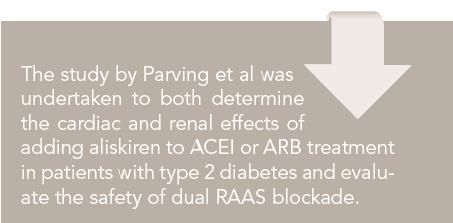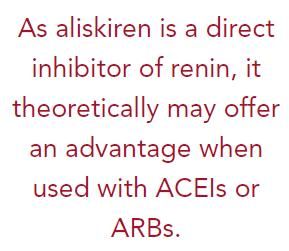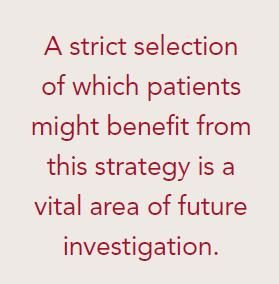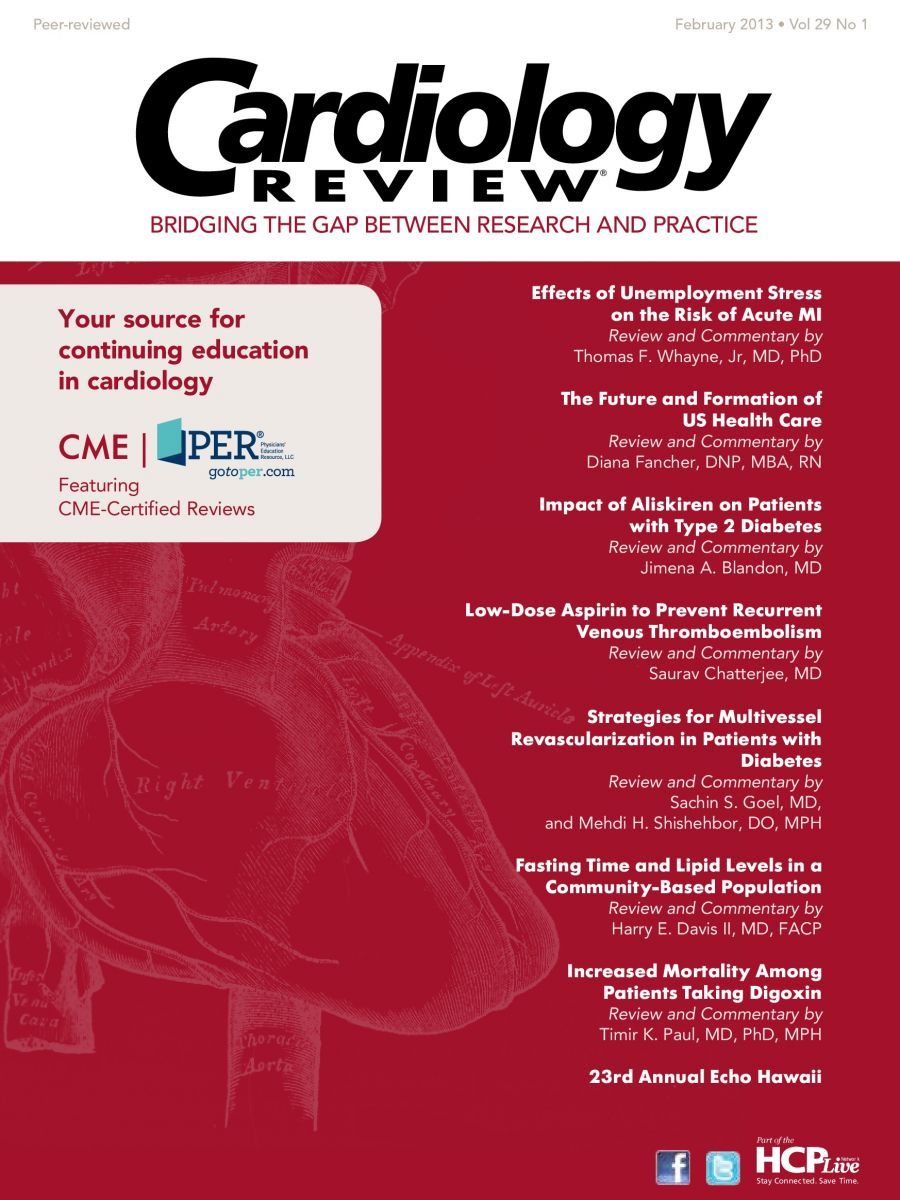Publication
Article
Cardiology Review® Online
Impact of Aliskiren on Patients with Type 2 Diabetes

Jimena A. Blandon, MD
Review
Diabetes mellitus is a growing epidemic worldwide, with 3.2 million diabetesrelated deaths reported annually, a number equivalent to that of HIV/AIDS-related deaths.1 In the United States about 24 million people are estimated to be affected by type 2 diabetes.1 The use of agents that block the renin-angiotensin-aldosterone system (RAAS) has been shown to reduce proteinuria and renal complications,2 but the utilization of 2 RAASblocking agents (eg, an angiotensin converting enzyme inhibitor [ACEI] and an angiotensin receptor blocker [ARB]) has only proved beneficial in heart failure (HF) trials3,4 and to decrease levels of proteinuria.5 There are no studies evaluating hard renal events or effects on diabetic patients with renal failure who have an increase in mortality due to coronary artery disease, stroke, and end-stage renal disease.

The formation of angiotensin I from angiotensinogen is mediated by renin.
Aliskiren is a direct renin inhibitor, resulting in angiotensin I suppression, which in turn decreases the formation of angiotensin II (Ang II) mediated by angiotensin-converting enzyme. Ang II can cause increased blood pressure via direct vasoconstriction, aldosterone release, and sodium retention, and also has a negative inhibitory feedback effect within the renal parenchyma to suppress the further release of renin. Thus, any reductions in Ang II levels will suppress this feedback loop, leading to further increased plasma renin concentrations (PRCs) and activity (PRA). This may pose a problem for ACEI and ARB therapy because increased PRA could partially overcome the pharmacologic inhibition of the RAAS. As aliskiren is a direct inhibitor of renin, it theoretically may offer an advantage when used with ACEIs or ARBs.
The present study was undertaken to determine the cardiac and renal effects of the addition of aliskiren to patients with type 2 diabetes who were already treated with either an ACEI or an ARB, and was designed to evaluate the safety of dual RAAS blockade.
Study Details

The study enrolled 8561 men and women 35 years older with type 2 diabetes and evidence of microalbuminuria (urine albumin creatinine ratio [UACR] ≥20 mg/g and <200 mg/g) and a mean estimated glomerular filtration rate [eGFR] ≥30 and <60 mL/min/1.73 m
20, macroalbuminuria (UACR ≥200 mg/g and eGFR ≥30 mL/min/1.73 m2), or cardiovascular disease (eg, myocardial infarction [MI], stroke, heart failure, or coronary artery disease) and a mean eGFR ≥30 and <60 mL/min/1.73 m2 from 853 centers in 36 countries. Study subjects were randomized to a double-blind, placebo- controlled trial and assigned to aliskiren (increased up to 300 mg once daily at 4 weeks postrandomization) versus placebo, and followed for a median of 32.9 months.
Exclusion criteria included serum potassium >5.0 mmol/L, type 1 diabetes mellitus, congestive HF (NYHA class III or IV), and concomitant treatment with >2 RAAS-blocking agents and potassium-sparing diuretics.
The primary end point was a composite of the time to cardiovascular death or a first occurrence of cardiac arrest with resuscitation; nonfatal MI; nonfatal stroke; unplanned hospitalization for HF; end-stage renal disease, death attributable to kidney failure, or the need for renal-replacement therapy with no dialysis or transplantation available or initiated; or doubling of the baseline serum creatinine level. The secondary cardiovascular outcome was a composite of all 5 cardiovascular components of the primary composite end point. Similarly, the secondary renal outcome was a composite of the renal components of the primary composite end point.
Both groups were similar in baseline characteristics; a majority of patients had chronic kidney disease (98.0%), and 84% had some level of proteinuria. This group had a high prevalence of hypertension and diabetes (94.5% and 82%, respectively), whereas 42.3% had any type of cardiovascular disease, other than hyper-tension—mainly coronary artery disease (CAD). During the trial, the use of most concomitant antihypertensive drugs remained nearly unchanged, as did the dose of the most commonly used ACEIs and ARBs.
The primary outcome occurred in 783 participants in the aliskiren group (18.3%) and 732 in the placebo group (17.1%) (hazard ratio (HR), 1.08 (95% confidence interval [CI], 0.98-1.20; P = 0.12). Patients with baseline potassium level of ≥5.0 mmol/L had a greater risk of the primary composite outcome compared with patients with a potassium level <5.0 mmol/L.
The secondary cardiovascular composite outcome occurred in 590 patients in the aliskiren group (13.8%) and 539 in the placebo group (12.6%) (HR, 1.11 [95% CI, 0.99- 1.25]; P = 0.09). All events were more frequent in the aliskiren group, especially cardiac arrest with resuscitation (18 vs 9) compared with placebo (HR, 2.40 [95% CI: 1.05-5.48]; P = 0.04), except unplanned hospitalization for HF: 205 versus 219 events compared with placebo (HR, 0.95 [95% CI, 0.87-1.23]; P = 0.74). The secondary renal composite outcome occurred in 257 patients in the aliskiren group (6.0%) and 251 in the placebo group (5.9%; HR, 1.03 [95% CI, 0.87-1.23]; P = 0.74).
Systolic blood pressure increased overall in both groups but less in the aliskiren group (P <0.001); diastolic blood pressure was also higher in the placebo group (P <0.001). Proteinuria at 6 months decreased more in the aliskiren group than in the placebo group (P <0.001). More patients taking aliskiren discontinued the study due to side effects compared with patients given placebo (P <0.001); hyperkalemia (P <0.001), renal impairment (P <0.001), and hypotension (P = 0.30) were more frequent in the aliskiren group.
Treatment with aliskiren had to be halted prematurely after results of a second interim efficiency analysis showed an increase in stroke events among patients taking aliskiren that later proved to be nonsignificant compared with placebo.
References
1. Melded S, Polonsky KS, Larsen PR, Kronenberg HM. Williams Textbook of Endocrinology. 12th ed. Philadelphia: Elsevier/Saunders; 2011:1371-1435.
2. Ting RZ, Luk AO, Chan JC. Treatment and landmark clinical trials for renoprotection. Contrib Nephrol. 2011;170:184-195.
3. McMurray JJ, Ostergren J, Swedberg K, et al. Effects of candesartan in patients with chronic heart failure and reduced left-ventricular systolic function taking angiotensin converting-enzyme inhibitors: the CHARM-Added trial. Lancet. 2003;362:767-771.
4. Krum H, Carson P, Farsang C, et al. Effect of valsartan added to background ACE inhibitor therapy in patients with heart failure: results from Val-HeFT. Eur J Heart Fail. 2004;6:937-945.
5. Kunz R, Friedrich C, Wolbers M, et al. Metaanalysis: effect of monotherapy and combination therapy with inhibitors of the renin angiotensin system on proteinuria in renal disease. Ann Intern Med. 2008;148:30-48.
6. Parving H-H, Brenner BM, McMurray J, et al. Cardiorenal end points in a trial of aliskiren for type 2 diabetes. N Engl J Med. 2012;367:2204-2213.
7. Schmieder RE, Hilgers KF, Schlaich MP, et al. Renin-angiotensin system and cardiovascular risk. Lancet. 2007;369:1208-1219.
8. Parving HH, Persson F, Lewis JB, et al. Aliskiren combined with losartan in type 2 diabetes and nephropathy. N Engl J Med. 2008;358:2433-2446.
Commentary Shedding Light on RAAS Manipulation
This study sheds additional light on the effects of manipulating the RAAS to improve outcomes in type 2 diabetes patients with proteinuria already taking ACEIs or ARBs, since previous use of either of these 2 latter agents, individually and especially in combination, has proved to decrease proteinuria and progression of renal disease at all stages of the continuum from subclinical microalbuminuria to endstage renal disease.7
The current study was a randomized clinical trial with an excellent design to assess the proposed end points. It is also the first study to use a combination of a renin inhibitor agent and either ARBs or ACEIs as background therapy for patients with type 2 diabetes and some level of renal insufficiency with proteinuria, but it failed to prove overall benefit over placebo and actually had to be stopped prematurely due to increased adverse effects.

However, some caveats need to be considered. It has been hypothesized that the benefits of this treatment rely on dual blockade of the RAAS, which has previously been shown to be beneficial, but in this group of patients the occurrence of hypotension and especially hyperkalemia apparently led the dual blockade of RAAS to cause more harm than good. Therefore, a strict selection of which patients might benefit from this strategy is a vital area of future investigation. Obviously, there are other factors beyond the beneficial effects of aliskiren on blood pressure and proteinuria that need to be taken into consideration before final recommendation of dual RAAS inhibition can be made.
Results from a number of studies suggest that aliskiren has positive effects on markers of cardiovascular and renal damage in patients with type 2 diabetes and nephropathy. The AVOID study compared the effects of aliskiren in addition to optimal antihypertensive therapy in patients with hypertension and type 2 diabetes complicated by nephropathy, and showed that the use of aliskiren 300 mg/d, compared with placebo, reduced the mean urinary albumin:creatinine ratio by 20% (95% CI, 9-30; P <0.001).8 Similarly, aliskiren is approved for treatment of hypertension.
It would be very useful to have another drug available to treat patients with type 2 diabetes, who often have associated conditions such as hypertension, proteinuria, and cardiovascular disease, putting them at high risk for major cardiac events. The results of the Parving et al study lead one to conclude that there is still a place for renin inhibition, but only if we can choose wisely as to which patients might be at risk for hypokalemia and hypotension and will require closer follow-up to prevent hypotension or imminent high levels of potassium (≥5 mmol/L). Ongoing studies with aliskiren in older patients and those with acute or chronic HF will add more data illuminating the exact role of this very promising drug in the cardiovascular armamentarium.
Until more data are gathered about adding aliskiren to ACEI or ARB therapies, we should follow current recommendations regarding double RAAS inhibition to add years of life to our patients with diabetes. We will be waiting with anticipation!
About the Author
Jimena A. Blandon, MD, is a third-year resident instructor in the Department of Internal Medicine at Texas Tech University Health Sciences Center in El Paso. She received her MD at Universidad del Valle, in Cali, Colombia. Dr Blandon will be continuing her training in a nephrology fellowship at Cleveland Clinic Florida.
Parving H-H, Brenner BM, McMurray JJV, et al. Cardiorenal end points in a trial of aliskiren for type 2 diabetes. N Engl J Med. 2012;367:2204-2213.





